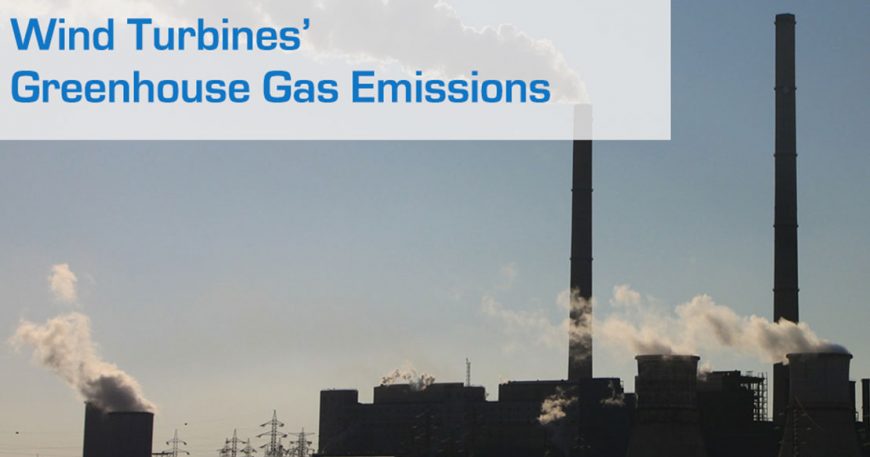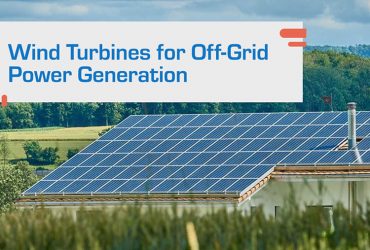
Does wind energy reduce greenhouse emissions?
In order to evaluate the sustainability of wind turbines comprehensively, it is important to understand how they are manufactured and operate. You can then get a sense of how exactly they cause greenhouse gas emissions.
How do wind turbines create emissions?
Materials production and transportation
Undoubtedly, the greenhouse gases emitted by wind turbines are not produced by the generation of wind energy itself, but by the manufacturing processes for the mechanical components needed to convert the kinetic into electric energy. This is a huge difference to other energy sources like coal power, since in the latter case, most of the CO2 emissions come directly from burning the coal during the energy generation process.
Most modern wind turbines mainly consist of a tower, blades and a nacelle containing a gearbox and a generator.
The tower is usually made of steel and supported by concrete. It is worth noting that steel is a heavy carbon-emitting material because of the chemical reduction required in its fabrication process. However, there are efforts being made by the steel industry to significantly reduce these emissions. While traditionally, carbon gases are used as a so-called reducing agent to transform iron ore into steel, the same results might also be achieved using hydrogen. The waste created by this reaction would only be water. In a nutshell, it is safe to say that the potential of producing ‘greener’ steel does exist.
Wind turbine blades usually consist of fibreglass-reinforced plastic. This material consists of two different components: Firstly, there are glass fibres. They are what gives the blades great strength and stress response. The material that makes up glass fibres is exactly the same that can also be used to produce drinking glasses – what makes the difference, is the manufacturing process. To transform liquid glass into glass fibres, it is spun into threads. This is done by simply drawing a thread from the melt, cooling it with water and wounding up. This process does not create a lot of greenhouse gases. It does have an environmental impact though because the raw material glass consists of quartz sand, which has to be withdrawn from natural resources.
The second component that goes into the fibreglass-composite is plastic. It is a well-known fact that to produce plastic, mineral oil is needed. This is a finite raw material during whose extraction, greenhouse gases are emitted.
It is important to note, though, that the carbon emissions created by wind turbine blades are rather low when compared to other industries and materials. The more significant environmental impact that they create is that because of the two-compound material, they prove to be very difficult, if not impossible, to recycle. This is a problem that wind turbine blades share with all products made of fibre-reinforced composites.
Wind energy’s life cycle analysis
The tool most commonly used to judge any product’s environmental impact is called life cycle analysis.
In the case of modern wind turbines, the factors taken into consideration will be materials production as mentioned before but also materials transportation, on-site construction and assembly, operation and maintenance, decommissioning and dismantlement.
The expected operation time for most wind turbines is somewhere around 20 to 25 years. Taking maintenance and other factors into account that might make the turbine stop moving for some share of this time, the net time of it running consistently is usually around 120,000 hours. Power output and all factors creating negative environmental impacts are then proportionally calculated over these operation times. International organisations such as the Intergovernmental Panel on Climate Chance IPCC conclude (in their 2018 report) that the CO2 equivalent produced per kWh of wind energy is 8g to 20g.
For comparison: the Co2 equivalent produced by gas is estimated (also by IPCC, in their 2011 report) to be between 270g to 910g, for coal it is even higher between 635g to 1.6kg. Depending on which numbers you pick for each energy source, in the worst case scenario (highest emission of 20g for wind energy, lowest of 270g/635g for the others), wind energy still only produces 7.4% of the greenhouse gases emitted by gas and only 3.2% of those of coal. Looking at the best case scenario (lowest emission of 8g for wind energy, the highest of 910g/1.6kg for the others), the difference is even more significant: wind energy might only produce 0.99% of emissions by gas and 0.56% of coal power.
The takeaway from this is: although sometimes marketed otherwise, wind power of course is not emissions-free – in fact, no machine or product is. However, since the operation of wind turbines itself does not contribute to greenhouse gas emissions, these emissions are really low, especially when compared to traditional methods of energy production. Moreover, it is possible to re-think production methods and supply chains to make for even less of a negative impact.
How do wind turbines save emissions?
In recent times, products and machines that are carbon-negative in a way that they actively extract greenhouse gases from the atmosphere have gained more and more attention. As seen before, wind turbines clearly do not fall in this category, since they actually produce greenhouse gases, even though only a little amount. It is still safe to say that wind energy saves greenhouse gas emissions. Since energy consumption is rising globally and traditional methods of energy generation produce huge amounts of greenhouse gases, each kilowatt that doesn’t need to be produced in these ways is a contribution to prevent more emissions.
Critics argue that the effective amount of energy provided by renewable energy is not as high as the net output of any turbine or photovoltaic system but will be significantly lower because of the energy that has to be put into production and operation. They usually point out that brake systems and power inverters that are included in most systems also consume some amount of energy. This is in fact a good point and needs to be taken into consideration during the design phase of any renewably energy system.
An interesting comparative value for that matter is a system’s so-called energy payback time. This is the time that is needed for the system to generate as much energy as was consumed during its production and will be during its lifetime operation. Simply put there is a point in time after which each additional kilowatt generated by the system can be seen as a saving in fossil fuel energy and its emissions. For each wind energy system, this moment will differ not only because of the system itself (as discussed above), but also because of its effectiveness, size and local wind speeds. Because of this, different sources specify different energy payback times for wind energy. For modern wind parks, most of these specifications range somewhere around three to nine months. Compare that to the overall operation time of over twenty years and you will find that these systems deliver up to 80 times more energy than they consume.
Researchers agree that wind energy has the lowest lifecycle emissions of all energy production technologies. Consider that almost all environmental problems that arise from wind energy (transportation, steel, concrete, construction and maintenance) are also present in most other technologies and that by using wind, huge factors like fossil fuel or coal use are omitted. WindEurope, the association for wind energy in Europe, states on their website that in 2020, wind energy will be able to avoid 342 million tonnes of CO2, which is the equivalent of taking 80% of Europe’s car fleet off the road.
Can wind energy replace the use of fossil fuels?
Asking whether wind energy has a net positive environmental impact and whether or not it can replace the use of fossil fuels altogether surely are very different questions. While there is usually less doubt regarding the environmental impact, there are several commonly heard myths around wind energy’s grid compatibility. One of them is that to balance the grid and prevent power blackouts, the complete wind power capacity needs to be backed up at all times by the same capacity of fossil fuel generation sources.
There is some truth to that: both wind and solar energy rely on heavily fluctuating resources. Neither wind nor the sun can simply be switched on like diesel generators. Because of this, renewable energy systems usually include some form of batteries and power converters that even these fluctuations out – especially, if they are stand-alone systems. In the case of grid-connected systems like huge power farms, another option is creating a very far-reaching net covering significant amount of land. Mostly, not all places have high wind speeds at the same time. Several places exchanging their generated energy could therefore lessen the demand of battery capacity. In their 2018 report, IPCC states that “managing the variability of wind power output has not been found to significantly degrade the [greenhouse gas] emissions benefits of wind energy”.
All in all, it is safe to say that there is great potential in wind energy and that the difficulties in expanding its use are definitely more of political and societal nature than of a technical one: unlike other promising energy generation technologies, wind energy’s potential is not conditioned on technological breakthroughs. After reviewing a wide range of possible scenarios, IPCC concludes that if ambitious efforts are made, wind energy’s contribution to the overall power generation could make up 21 to 25 per cent by 2050.
Related Content
Generally speaking, the term ‘off-grid’ refers to buildings, communities or a lifestyle that are not connected to some or all public utilities. Usually, the main...
